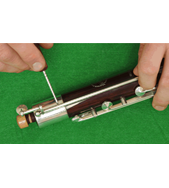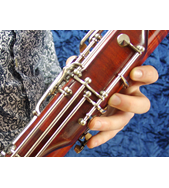Help – my bassoon has a crack!
May 16th, 2018

Bassoon tenon with large crack in need of repair work, taken by Richard Craig in Australia, a professional bassoon repairer who carried out the repair on this bassoon.
Article Author: Martin Ludlow, In-House-Bassoon Specialist and Director at Double Reed Ltd.
This article is in our series on pre-war bassoons. However, bassoons of any age will crack if not carefully handled, so this article applies to bassoons of any age.
Cracks and a bassoon’s inherent design
Virtually all bassoons are made from a slow-growing, dense maple. Maple is a hardwood selected for its tonal characteristics, workability and durability, and is ideal for the demands which being made into a bassoon puts upon it.
Owing to the qualities of maple and the fact that the wood is aged for between five and ten years typically before being made into a bassoon, cracks caused by the wood drying out are virtually unheard of.
Therefore, any cracks in a bassoon can almost invariably be attributed to the way it is handled rather than to any defects in the wood or manufacturing techniques (bassoons do require great care in handling and, unfortunately, mishaps can cause cracks in even the most carefully-handled bassoons).
However, a bassoon’s inherent design does make it vulnerable to cracking. This is because a bassoon is made from long pieces of wood which are joined together in a way which enables them to come apart. This makes the bassoon particularly vulnerable at the points at which they slot together. Lateral force applied to one bassoon joint, while another one into which it slots is fixed, will result in high levels of stress at the point where they join.
Where do cracks most often occur?
Tenons (the thinner-walled ends of the long joint and one end of the wing joint which slot into other joints) are particularly vulnerable to cracking because the wood is so thin at these points, and this is the place at which maximum lateral stress is focused if a bassoon is knocked or pushed from the side.
Tenon rings, when present, help to protect these areas, but do not always provide a perfect solution if a bassoon is knocked or pushed hard enough. Body bands around the areas which accept the tenons protect the often-equally-thin wood in these places, and they very rarely crack because of this.
Another vulnerable area is the end of the bell joint. Bell rings were invented to protect the end of the bell joint against, for example, a bassoon being swung round and hitting a solid object such as a wall (many of the bassoons we see have cracked bell rings when they come to us). However, if a cracked bell ring is not repaired or replaced and the bassoon is again knocked hard, the protection provided by the bell ring will be largely ineffective.
Finally, the thin piece of wood between the two bores at the top of the boot joint is prone to cracking as the wood in this area takes the strain of the other three joints. However, this area is protected by a body band to contain the forces exerted on it so cracks are rarely anything except superficial. Also, as the tenons of the long and wing joints carry the sound at this point a good air seal is preserved despite a crack being present. Therefore, cracking in this area is not a cause for concern for either playability or longevity.
Should cracks be left?
Cracks in bassoons, other than in the boot joint as above, should be attended to as soon as they appear, to stop them growing and eventually affecting the performance of the bassoon. Performance will be affected quite badly once a crack extends into the main bore of the bassoon, as air will be able to leak out freely from the crack - and any air leaks will degrade a bassoon’s performance.
The most straightforward cracks to treat are tenon cracks. Very small ones can be dealt with in situ, topped off with a new metal tenon ring; larger ones may require replacement of the tenon. Although a skilled job, this at the more routine end of things as far as bassoon overhauls go and is not prohibitively costly.
The repair approach for cracks elsewhere depends on the length and position of the crack, the value of the bassoon and the wishes of the owner, so it is difficult to prescribe general remedies.
Cracks, however, are rarely, if ever, terminal for a bassoon as long as the bassoon is worth saving. If a crack runs through a tone hole it can be a bit more problematic to fix, but essentially any crack is repairable – but the longer the crack, the more complex and costly it will be to fix.
If you have a crack in your bassoon please get in touch for a discussion about it. We will initially need one or more photographs of the crack and then we can decide between us the best way to proceed.



